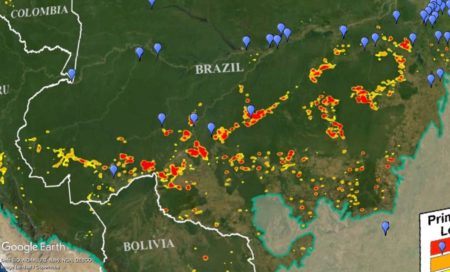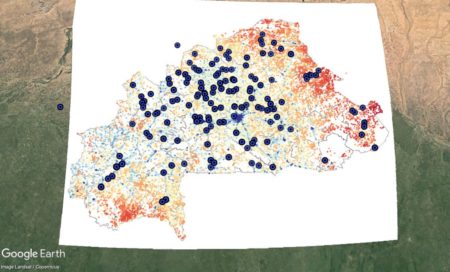- IFAD says farmers might need to change crops. Farmers unavailable for comment as presumably they’re too busy changing crops.
- Case in point: China moves into cacao.
- The food system is at the centre of all our ills. But I’m not sure switching from maize to sorghum is going to cut it.
- And neither will watching those food miles, alas.
- Example of a farmer changing crops, watching food miles and diversifying the food system.
- I suppose we could also just eat more trees?
- We’ll need ethnobotanists for that.
- And there’s clearly plenty of pumpkins out there.
- Maybe garum would go well with some of those NTFPs, and pumpkins.
- Do they teach garum at Fermentation School?
- Whoa, I did not realize archaea in the vertebrate gut feed on bacterial fermentation products.
- And let’s not forget to put everything in genebanks before it’s too late so we have a chance to do all of the above.
Questioning maps
As regular readers know all too well, I can’t resist a map mashup. So when I saw the latest data on deforestation in the Amazon, I fired up MapWarper and GoogleEarth and got to work.
And here’s a look at how recent deforestation in Brazil relates to the localities of past cassava collecting, at least as far as Genesys knows about it.
Now, I don’t know in what way deforestation (and associated disruptions) relates to loss of cassava diversity, but there’s a chance that it might. Could make an interesting PhD project for someone.
Anyway, encouraged by my pretty result, and remembering that I wanted to do something with some shiny new maps I had heard about, I next mashed up sorghum accessions and poverty in Burkina Faso. Here’s what I got.
What’s going on? Why are there relatively fewer sorghum accessions where poverty is higher (more red)? Are those places just harder to reach? Or do people there really grow less sorghum.
Again, I don’t know. But I think it would be interesting to find out.
All speculation welcome in the comments.
Brainfood: RICA, AEGIS, CWR, Agrosavia, DSI, CRISPR, Tradition, SNS, Stability, Birds, Sparing, Genetic erosion
- RICA: A rice crop calendar for Asia based on MODIS multi year data. RiceAtlas validated. Still trying to figure out how to mash it up with genebank accession locality data though. Any GIS geniuses out there to help me?
- AEGIS, the Virtual European Genebank: Why It Is Such a Good Idea, Why It Is Not Working and How It Could Be Improved. Certify genebanks, that’s how.
- Reap the crop wild relatives for breeding future crops. Needs good data and certified genebanks. Plus gene editing.
- Opportunities and Challenges to Improve a Public Research Program in Plant Breeding and Enhance Underutilized Plant Genetic Resources in the Tropics. Needs better social networking. Plus better data and certified genebanks, presumably.
- From seed to sequence: Dematerialization and the battle to (re)define genetic resources. Ah yes, data.
- Current Advancements and Limitations of Gene Editing in Orphan Crops. Ah yes, gene editing.
- Revitalizing Traditional Agricultural Practices: Conscious Efforts to Create a More Satisfying Culture. Meanwhile, in Sweden…
- Sacred natural sites and biodiversity conservation: a systematic review. Of course sacred sites are good for biodiversity. But it’s always good to have the data.
- Global relationships between crop diversity and nutritional stability. Sacred sites are not enough, alas.
- Preserving local biodiversity through crop diversification. Crop diversity is even good for birds…
- Concentrating vs. spreading our footprint: how to meet humanity’s needs at least cost to nature. …but, overall intensification of agriculture coupled with sparing land for conservation (maybe even in sacred sites) is the best approach for wildlife. And humanity, for that matter. So, back to needing better data from certified genebanks, so we can get that intensification done, right?
- Quantifying the scale of genetic diversity extinction in the Anthropocene. Right!
Nibbles: Oil palm, Diverse forestry, Financing biodiversity
- Parasites of oil palm monocultures as avatars of hope and justice.
- 30 ways to leave your monoculture.
- French take on investing in natural capital. Hopefully not oil palm monocultures though.
Brainfood: Cola trade, Amalfi terraces, Satoyama value, Burkinabe cattle, Tree planting, Chickpea adoption, Varietal diversification, Wheat diversity, Maize adaptation, Stress breeding, Root & tubers, Cropping data
- Evidence of an Eleventh-Century AD Cola Nitida Trade into the Middle Niger Region. Before then, there was not much trade between the savannah and forest zones of West Africa, which is kind of remarkable.
- Risk factors and plant management activities for the terraced agricultural systems on the Amalfi coast (Italy): an interdisciplinary approach. The terrace walls need agriculture just as much as agriculture needs the walls. Had me wondering whether those terraces were there when the cola trade started up in West Africa.
- Nexus of the awareness of ecosystem services as a “public-benefit value” and “utility value for consumption”: an economic evaluation of the agricultural culture of Satoyama in Japan. Ecosystem services are hard to sell. Probably in Amalfi too, I bet.
- Values and Beliefs That Shape Cattle Breeding in Southwestern Burkina Faso. Community-based breeding programmes need trusted leadership. Don’t we all.
- Limited effects of tree planting on forest canopy cover and rural livelihoods in Northern India. Decades of tree planting wasted. If only there had been better leadership.
- Unplanned but well prepared: A reinterpreted success story of international agricultural research, and its implications. Yeah, but even when an intervention is a success, as in this case, the reasons are beyond the control of researchers. The lesson: plan for the unplannable…
- Smallholder farmer engagement in citizen science for varietal diversification enhances adaptive capacity and productivity in Bihar, India. …and bet on diversity, of course…
- Introducing Beneficial Alleles from Plant Genetic Resources into the Wheat Germplasm. …like wheat breeders have been doing…
- A B73 x Palomero Toluqueño mapping population reveals local adaptation in Mexican highland maize. …and maize farmers too for that matter.
- Developing climate-resilient crops: improving plant tolerance to stress combination. And the need for diversity is only going to increase.
- Suitability of root, tuber, and banana crops in Central Africa can be favoured under future climates. I wouldn’t plan on it though…
- A review of global gridded cropping system data products. …but it’s good to finally know how all the different products that can be used to make these predictions stack up against each other.

